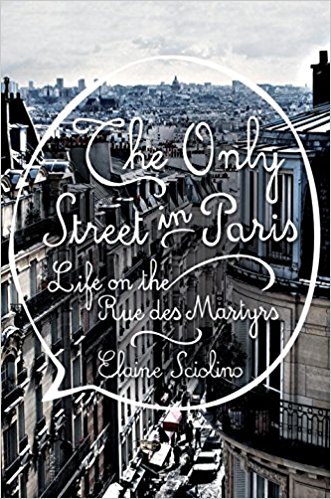The Only Street in Paris by Elaine Sciolino
Written by Ashley Kelmore, Posted in Reviews
Three Stars
Best for: Those who love Paris and enjoy learning more about specific neighborhoods (or in this case, a single street).
In a nutshell: U.S. ex-pat and journalist Ms. Sciolino provides a look at the individuals who live and work on the Rue des Martyrs, providing current information and a look at the history of the street.
Line that sticks with me: “A hardware store has been at No. 1 since 1865.” (p 56)
Why I chose it: On our whirlwind visit to 19 independent books stores on Seattle Bookstore Day, we stopped at a travel bookstore and saw this. I love Paris, and liked the idea of learning the stories of a few people from one neighborhood.
Review: This book has some really lovely moments, and a few questionable editorial choices. Ms. Sciolino moved to Paris in 2002, and to the Rue des Martyrs a few years later. After her editor suggested she write an article on the closing of a fish shop on the street, she decided to explore the area more, focusing just on the people and shops of this single strip in Paris, stretching from the 9th to the 18th arrondissements.
Some of the stories are lovely and sweet, providing a look at the lives of current business owners who carry on traditions for years. Some locations have had the same type of business in it for literally decades if not longer. The stories also often have a bit of history in them, especially the recurrent theme of the origin story of Saint Denis (and Catholicism in general). I could picture some of the locations, having been to Paris and walked down this street before; mostly it just made me want to return.
As I said up front, there were a couple of decisions that I found somewhat questionable. The first was the repeated use of the term ‘transsexual’ when describing a cabaret that feature drag shows (http://www.michou.com/fr/un-spectacle-innoubliable/). I appreciate that I may be lacking in knowledge in this area, but my understanding has been that this term is, if not insulting, as least displays ignorance. But again, I’ve been wrong in the past. Regardless, it was jarring to read repeatedly.
The second is her picking and choosing which religious beliefs to spend time on. There is a chapter that is (mostly) well done that focuses on Jewish life on the Rue; in it Ms. Sciolino discusses the Jewish schoolgirls who were killed after France did not protect them during WWII, the Nazi occupation, and explores the Jewish heritage of this street. She also spends considerable time — and a few chapters — discussing the Catholic history of the street. Is there no Muslim history she could have explored? Are any of the shopkeepers she interviewed Muslim, and have they found challenges with the rise in French anti-Muslim sentiments? This perspective would have been nice to learn about.
Finally, she’s clearly an upper-middle-class woman who may truly be friends with some of the shopkeepers, but others she interviewed may have just been humoring her inquiries as they did not wish to lose her business.
That aside, this is still a book I would probably recommend to someone about to visit Paris and stay in the 9th or 18th arrondissement.

